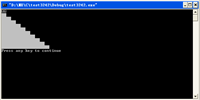移动两城一家,钢筋表示符号,523au
mfc中有两类线程,分别称之为工作者线程和用户界面线程。二者的主要区别在于工作者线程没有消息循环,而用户界面线程有自己的消息队列和消息循环。
工作者线程没笑消息机制,通常用来执行后台计算和维护任务,如冗长的计算过程,打印机的后台打印等。用户界面线程一般用于处理独立于其他线程之外的用户输入,响应用户及系统产生的事件和消息等。但对于win32的api编程而言,这两种编程是没有区别的,他们都只需要线程的启动地址即可启动线程来执行任务。
在mfc中,一般用全局函数afxbeginthread()来创建并初始化一个线程的运行,该函数有两种重载形式,分别用于创建工作者线程和用户界面线程。这两种函数的重载和原型分别说明如下:
(1)工作者线程
cwndthread *afxbeginthread(afx_threadproc pfnthreadproc,
lpvoid pparam,
uint npriority=thread_priority_normal,
uint nstacksize = 0,
dword dwcreateflags = 0,
lpsecurity_attributes lpsecurityattrs = null);
(2)iu线程(用户界面线程)
cwndthread *afxbeginthread(cruntimeclass *pthreadclass,
int npriority=thread_priority_normal,
uint nstacksize = 0,
dword dwcreateflags = 0,
lpsecurity_attributes lpsecurityattrs = null);
afxbeginthread()创建线程的流程不论哪个afxbeginthread(),首先都是创建mfc线程对象,然后创建win32线程对象。

afxbeginthread创建线程的流程图
mfc线程技术剖析
mfc的核心类库中有一个名为cwinthread的类,这个类在mfc的底层机理中占举足轻重的地位。
mfc应用程序 
线程状态用类_afx_thread_state描述,模块状态用类_afx_module_state描述,模块-线程状态用类_afx_module_thread_state描述。这些类从类cnotrackobject派生。进程状态用类_afx_base_module_state描述,从模块状态_afx_module_state派生。进程状态是一个可以独立执行的mfc应用程序的模块状态。还有其他状态如dll的模块状态等也从模块状态类_afx_module_state派生。

mfc状态类的层次

模块、线程、模块-线程状态的关系
多线程实践案例:(多线程文件查找器)
查找文件的时候,首先用findfirstfile函数,如果函数执行成功,返回句柄hfindfile来对应这个寻找操作,接下来可以利用这个句柄循环调用findnextfile函数继续查找其他文件,知道该函数返回失败(false)为止。最后还要调用findclose函数关闭hfindfile句柄。
hfindfile = ::findfirstfile(lpfilename,lpfinddata);
if(hfindfile != invalid_handle_value)
{
do // 处理本次找到的文件
{
}while(::findnextfile(lpfilename,lpfinddata));
::findcolse(hfindfile);
}
文件搜索器要在指定的目录及所有子层目录中查找文件,然后向用户显示出查找的结果。如果使用多线程的话,就意味着各线程要同时在不同目录中搜索文件。
这个程序最关键的地方是定义了一个动态的目录列表。
ctypedsimplelist<cdirectorynode *> m_listdir;
struct cdirectorynode : public cnotrackobject
{
cdirectorynode* pnext; // ctypedsimplelist类模板要用次成员
char szdir[max_path]; // 要查找的目录
}
在线程执行查找文件任务的时候,如果找到的是目录就将它添加到列表中,若找到的是文件,就用自定义checkfile函数进行比较,判断是否符合查找条件,若符合就打印出来,显示给用户。线程在查找完一个目录以后,再从m_listdir列表中取出一个新的目录进行查找,同时将该目录对应的结点从表中删除。
当m_listdir为空时,线程就要进入暂停状态,等待其他线程向m_listdir中添加新的目录。
案例:
rapidfile.h文件
#pragma once
#include <afxwin.h>
struct cdirectorynode : public cnotrackobject // 创建文件夹目录结构体
{
cdirectorynode *pnext; // 文件夹目录的下一个指针
char szdir[max_path]; // 文件夹名称
}
class crapidfinder
{
public:
crapidfinder(int nmaxthread); // 构造函数
virtual ~crapidfinder(); // 虚析构函数
bool checkfile(lpctstr lpszfilename); // 匹配文件夹名字
int m_nresultcount; // 结果的数量
int m_nthreadcount; // 活动线程的数量
ctypesimplelist<cdirectorynode *> m_listdir; // 文件夹列表
critical_section m_cs; // 临界区
const int m_nmaxthread; // 最大线程数量
char m_szmatchname[max_path]; // 最大搜索的文件
// 通知线程的工作状态
handle m_hdirevent; //我们向m_listdir添加新的目录,10个线程 9个停止,1个工作 若m_listdir为空,线程不能停止
handle m_hexitevent; // 各个搜索线程是否已经结束
}
rapidfile.cpp文件
#include "rapidfile"
#include <string>
crapidfinder::crapidfinder(int nmaxthread) : m_nmaxthread(nmaxthread)
{
m_nresultcount = 0;
m_nthreadcount = 0;
m_szmatchname[0] = '\0';
m_listdir.construct(offsetof(cdirectorynode,pnext)); // 创建ctypedsimplelist
m_hdirevent = ::createevent(null,false,false,null);
m_hexitevent = ::createevent(null,false,false,null);
::initializecriticalsectioin(&m_cs);
}
crapidfinder::~crapidfinder()
{
::closehandle(m_hdirevent);
::closehandle(m_hexitevent);
::deletecriticalsection(&m_cs);
}
// 查找文件名
bool crapidfinder::checkfile(lpctstr lpszfilename)
{
char str[max_path];
char strsearch[max_path];
strcpy(str,lpszfilename);
strcpy(strsearch,m_szmatchname);
_strupr(str); // 将字符串全部转换为大写
_strupr(strsearch);
if(strstr(str,strsearch) != null) // 查找的文件名在里面
{
return true;
}
return false;
}
multithreadfindfile.cpp
#include <stdio.h>
#include <afxwin.h>
#include "rapidfile.h"
uint finderentry(lpvoid lpparam)
{
crapidfinder *pfinder = (crapidfinder *)lpparam;
cdirectorynode *pnode = null; // m_listdir从pnode中获取
bool bactive = true; // 线程状态
// 只要m_listdir有目录
while(1)
{
// 取出新目录 互斥的取待查目录
::entercriticalsection(&pfinder->m_cs);
if(pfinder->m_listdir.isempty())
bactive = false;
else
{
pnode = pfinder->m_listdir.gethead();
pfinder->m_listdir.remove(pnode);
}
::leavecriticalsection(&pfinder->m_cs);
// bactive指示了当前线程的工作状态,如果m_listdir队列当前为空,那么我们当前线程先等待
if(!bactive)
{
::entercriticalsection(&pfinder->m_cs);
pfinder->m_nthreadcount--;
if(pfinder->m_nthreadcount == 0)
{
::leavecriticalsection(&pfinder->m_cs);
break;
}
::leavecriticalsection(&pfinder->m_cs);
// 进入等待状态
resetevent(pfinder>m_hdirevent);
::waitforsingleobject(pfinder->m_hdirevent,infinite);
::entercriticalsection(&pfinder->m_cs);
// 此时当前线程再度获得cpu的推进机会
pfinder->m_nthreadcount++; // 当前的活动线程数量加1
::leavecriticalsection(&pfinder->m_cs);
bactive = true;
continue;
}
// 实现基于pnode的目录查找
win32_find_data filedata;
handle hfindfile;
if(pnode->szdir[strlen(pnode->szdir)-1] != '\')
strcat(pnode->szdir,'\\');
strcat(pnode->szdir,"*.*");
hfindfile = ::findfirstfile(pnode->szdir,&filedata);
if(hfindfile != invalid_handle_value)
{
do
{
if(filedata.cfilename[0] == '.')
continue;
if(filedata.dwfileattributes & file_attribute_directory)
{ // 是目录,添加到m_listdir
cdirectorynode *p = new cdirectorynode;
strncpy(p->szdir,pnode->szdir,strlen(pnode->szdir)-3);
strcat(p->szdir,filedata.cfilename);
::entercriticalsection(&pfinder->m_cs);
pfinder->m_listdir.addhead(p);
::leavecriticalsection(&pfinder->m_cs);
// 置信一个事件
::setevent(pfinder->m_hdirevent);
}
else // 文件
{
if(pfinder->checkfile(filedata.cfilename)) // 找到文件名
{
::entercriticalsection(&pfinder->m_cs);
::interlockedincrement((long *)&pfinder->m_nresultcount);
::leavecriticalsection(&pfinder->m_cs);
printf("%s \n",filedata.cfilename);
}
}
}while(::findnextfile(pnode->szdir,&filedata));
}
// 此节点的保存的目录已经全部搜索完毕
delete pnode;
pnode = null;
}
::setevent(pfinder->m_hexitevent);
// 判断当前线程是否是最后一个结束循环的线程
if(::waitforsingleobject(pfinder->m_hdirevent,0) != wait_timeout)
{ // 通知主线程,最后一个搜索线程已经结束了
::setevent(pfinder->m_hexitevent);
}
return 0;
}
int main(void)
{
crapidfinder *pfinder = new crapidfinder(64); // 开64个线程
cdirectorynode *pnode = new cdirectorynode; // 创建结点
char szpath[] = "c:\\"; // 需要查找的目录
char szfile[] = "stdafx"; // 需要查找的字符串
// 对crapider的信息进行设置
strcpy(pnode->szdir,szpath); // 设置要搜索的目录
pfinder->m_listdir.addhead(pnode); // 将要搜索的目录添加到list中,当做头结点
strcpy(pfinder->m_szmatchname,szfile); // 需要搜索的文件名
// 创建辅助线程
pfinder->m_nthreadcount = pfinder->m_nmaxthread;
// 创建辅助线程,并等待查找结束
for(int i =0; i < pfinder->m_nmaxthread; i++)
{
afxbeginthread(finderentry,pfinder);
}
waitforsingleobject(pfinder->m_hexitevent,infinite);
// 打印查找结果
printf("一共找到同名文件%d个\n");
delete pfinder;
system("pause");
return 0;
}
如对本文有疑问,请在下面进行留言讨论,广大热心网友会与你互动!! 点击进行留言回复


如何在没有core文件的情况下用dmesg+addr2line定位段错误

用QT制作3D点云显示器——QtDataVisualization
网友评论